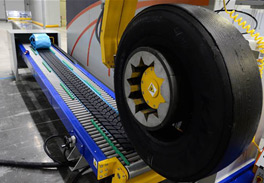Tire market expecting domestic sales growth
 The Russian tire market shrank by approximately 11% in 2016, following the 20% plummet in 2015. Yet foreign majors survived the two crisis years on growing exports and even expanded their production last year. The tire output may continue to increase this year, as principal actors are expecting a domestic sales growth following anticipated car market recovery.
The Russian tire market shrank by approximately 11% in 2016, following the 20% plummet in 2015. Yet foreign majors survived the two crisis years on growing exports and even expanded their production last year. The tire output may continue to increase this year, as principal actors are expecting a domestic sales growth following anticipated car market recovery.
The fall of the Russian tire market continued last year, although at lesser rates. Michelin estimated the Russian market decline at 11% on the average in late 2016 to 30.8 million tires. Market actors told Kommersant in 2015 the market fell by approximately 20% and added that they were trying to compensate for the deficit of domestic demand with exports. The trend persisted last year, when, according to certain majors, tire production in Russia grew a bit thanks to exports.
The output of the Continental plant in Kaluga grew by 50% to 3 million tires, the company said yesterday. The plant aims to increase production by 100,000 tires in 2017. Besides, the range of Continental products will grow by 30 types; for now Kaluga produces about 300 types of tires. Thirty percent of products were exported, and Canada and China were added to the plant’s markets in 2016. A representative of another market actor, Finnish Nokian Tyres, said the company was selling on the Russian market up to 40% of tires made in the Leningrad region before the crisis started in 2014. Now the domestic sales are down to 15–20%, and the rest of products are exported.Michelin declined to disclose the 2016 output but said that the company continued to develop in Russia in late 2016 despite the crisis – a new range of tire products (Primacy 3) began at the plant in the Moscow region with the rated annual capacity of 1.5-2 million tires, and production of 17 inch tires began (prior to that the plant was making only 13 to 16 inch tires). Michelin representatives said the company is set to increase production in 2017 and hopes that the domestic market will grow “as a result of upward trends in new car sales.” Other market actors and the Association of European Businesses did not reply to the Kommersant inquiry yesterday.
According to Germany’s GfK, a decline on the Russian tire market started in 2014, when sales dipped by 17.5%. Back then Continental expected the market to recover only by 2020. Kommersant failed to obtain an updated forecast from the company yesterday. Still, certain segments, for instance, the segment of off-road tires, have been growing. Michelin said that 4x4 tire segment accounted for 18.5% of sales (5.7 million tires) and was dealing with the crisis better than the market as a whole.
Companies carry on their investment programs despite the fall in domestic market demand. A Bridgestone plant was commenced in Ulyanovsk in December 2016 (investments stood at 12.5 billion rubles). The company declared the annual output of 2 million tires, with the future production increase to 4 million tires a year, “alongside recovery of the car market.” In early December, the Nokian Tyres group announced the prospective launch of an additional production line with the annual output of roughly 1.5 million tires in the Leningrad region in 2017, which means the plant’s total capacity will reach 17 million tires a year. Head of the group’s Russian business Andrei Pantyukhov said that the Russian market was showing “tentative signs of stabilization or even recovery.” Yesterday, Continental declared plans to expand production facilities in order to be prepared for “the market change.” In 2015, the company postponed the operation of its Kaluga plant at full capacity until 2017 due to “the economic situation.”
Vladimir Bespalov of VTB Capital agrees that the tire market may stabilize and recover. That will happen due to the stabilization of the car market and the economy in general, improvement of consumer sentiment and realization of the deferred demand. Besides, foreign companies operating on the Russian market manage to compensate for the lack of domestic demand with exports.
Source: http://kommersant.ru/doc/3188643
Yana Tsinoyeva, Kommersant, issue No4 dated 12.01.2017, p. 9

